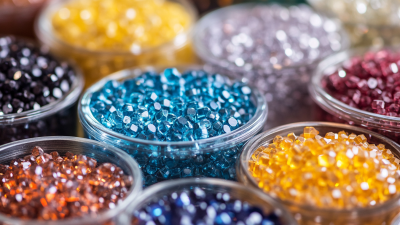The world of glass beads is a fascinating tapestry that weaves together ancient artistry and contemporary design, showcasing the remarkable journey these tiny, colorful orbs have undertaken throughout history. From their origins in primitive societies, where they were crafted by hand and imbued with cultural significance, to their modern iterations that grace high-fashion collections, glass beads have continuously evolved, reflecting changes in artistic expression, technology, and social values.

This article delves into the rich history and techniques of glass bead making, illustrating how traditional methods are being revitalized and reimagined by today's designers. By exploring the transformative journey of glass beads, we uncover not only the craftsmanship behind these luminous creations but also the enduring allure they hold in various design contexts, bridging the gap between past and present in the world of art and fashion.
Glass beads have captivated human imagination for millennia, serving not only as decorative items but also as carriers of cultural significance. Dating back to ancient civilizations, these beads were crafted in various forms, from the intricate designs of Mesopotamian artisans to the colorful creations of Egyptian tombs. Their production often involved sophisticated techniques such as core forming and wound glass, making them coveted items for trade and adornment. As societies evolved, the allure of glass beads persisted, reflecting social status and spiritual beliefs across various cultures.
During the Middle Ages and the Renaissance, glass beads found their way into Europe through trade routes, enriching the craftsmanship of local artisans. These beads became an essential component of jewelry, garments, and religious artifacts, seamlessly integrating into fashion and ritual. In this period, the shift toward mass production allowed for greater accessibility, further embedding their importance in everyday life. Today, modern designers continue to draw inspiration from this rich heritage, using glass beads to create innovative works that pay homage to their historical roots while pushing the boundaries of contemporary design.
 The journey of glass beads reflects an evolution intertwined with the creativity of artisans throughout history. Ancient cultures, from the Egyptians to the Romans, harnessed primitive techniques, including core-formed and wound-glass methods, to craft intricate bead designs, a practice that significantly shaped their artistic landscapes. According to a report by the International Society of Glass Beadmakers, around 85% of historical bead manufacturing involved hand techniques, showcasing a deep-rooted tradition that emphasizes artisanal skill and creativity.
The journey of glass beads reflects an evolution intertwined with the creativity of artisans throughout history. Ancient cultures, from the Egyptians to the Romans, harnessed primitive techniques, including core-formed and wound-glass methods, to craft intricate bead designs, a practice that significantly shaped their artistic landscapes. According to a report by the International Society of Glass Beadmakers, around 85% of historical bead manufacturing involved hand techniques, showcasing a deep-rooted tradition that emphasizes artisanal skill and creativity.
As we transition into contemporary art, artists utilize modern tools and methods while paying homage to these ancient traditions. Contemporary glass artists have embraced advancements in technology, such as furnace-working and kiln-casting, to produce unique designs that push the boundaries of glass manipulation. Recent statistics from the Craft Industry Alliance indicate that the market for handmade glass items, including beads, has surged by 35% over the past five years, signaling a growing appreciation for both historical and modern glass artistry. This blend of old and new not only highlights the versatility of glass as a medium but also signifies a continuous lineage of artistic expression that transcends generations.
The influence of
glass beads
spans centuries and cultures, intertwining ancient artistry with contemporary design practices. Historically, glass beads were not merely decorative items but served as vital trade goods, symbolic markers, and artistic expressions across various civilizations. Reports indicate that jewelry incorporating glass beads has seen a resurgence in popularity, with an expected market growth of
8.7% annually,
reflecting consumers' renewed appreciation for culturally significant design elements.
In exploring global modernism, we can observe how artists and designers, such as those showcased in the Bear Walker Society's exhibit, draw inspiration from diverse cultural artifacts. For example, rooted in rich traditions, the textures and motifs found in embroidered Suzani fabrics or the craftsmanship of South African mud beads resonate with the color and design sensibilities of glass beads. As evidenced by recent trends in fashion and home decor, designers are increasingly embracing these cross-cultural influences, embedding a narrative of global interconnectedness into their work. This fusion not only pays homage to the ancient origins of these items but also opens up pathways for innovative designs that tell diverse stories through craftsmanship.

The evolution of glass bead production has been remarkably influenced by modern technologies, resulting in innovations that not only enhance efficiency but also elevate design aesthetics. According to a recent report by the Glass Industry Association, advancements in precision molding and 3D printing have reduced production times by up to 40%. These technologies allow artisans to experiment with more intricate designs and customizable options, which were previously infeasible with traditional handcrafting methods. This shift has led to a revival in demand for glass beads in various applications, ranging from jewelry to home décor.
Tip: Consider investing in software that simulates bead designs before production. This practice can help minimize waste and optimize the use of materials, ensuring sustainability in your projects.
Moreover, the incorporation of automation in glass melting processes has resulted in a significant decrease in energy consumption, with reports indicating a 20% reduction in overall emissions. This not only meets the increasing consumer demand for environmentally friendly products but also opens the door for small businesses to compete in the global market. Staying informed about these technological advancements can help designers tap into new trends and methods, positioning them advantageously in an ever-evolving industry.
Tip: Stay connected with industry webinars and workshops to learn about the latest technologies and techniques. Networking with fellow artisans can provide valuable insights and inspiration for your own glass bead creations.
Incorporating glass beads into today’s fashion and decor offers a vibrant way to express individuality and creativity. One effective method is to use glass beads as accents in clothing and accessories. For instance, sewing them onto a plain denim jacket can instantly elevate the piece, transforming it into a unique fashion statement. Similarly, adding beaded details to handbags or shoes can bring a playful touch that catches the eye. Experimenting with different sizes, colors, and types of glass beads allows for a dynamic, personalized design that speaks to one's style.
When it comes to decor, glass beads can be integrated in countless ways. Consider using them in table centerpieces or as part of a decorative bowl to create a stunning visual effect. Stringing beads to create garlands or wall hangings adds texture and color to any space, perfect for enhancing a room’s atmosphere. Additionally, incorporating glass beads into DIY projects, such as custom lampshades or curtain tiebacks, offers endless opportunities to infuse charm and elegance into your home. By embracing the beauty of glass beads, designers can create captivating ensembles and interiors that reflect both historical artistry and modern aesthetics.
| Dimension | Description | Application in Modern Design |
|---|---|---|
| Historical Significance | Glass beads have been used for thousands of years, serving as currency, jewelry, and decorative elements. | Utilized in modern jewelry pieces to create unique cultural statements. |
| Material Variety | Glass beads are made from various types of glass, offering a range of colors and finishes. | Incorporated in fashion accessories for vibrant and eye-catching designs. |
| Design Techniques | Techniques include stringing, weaving, and embedding into other materials. | Used in home decor items like vases and wall art to add texture and richness. |
| Cultural Impact | Glass beads represent the heritage and craftsmanship of various cultures. | Reflected in contemporary collections that celebrate traditional craftsmanship. |






